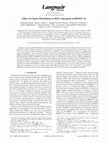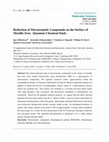Papers by Jerzy Leszczynski
Chemical Physics, 2000
The existence of GeH3+(H2)n species for n upto 11 is predicted. The formation of clusters is base... more The existence of GeH3+(H2)n species for n upto 11 is predicted. The formation of clusters is based on the consecutive filling of distinct shells. H2 molecules, members of the same shell, possess similar properties as is indicated by their predicted properties including dissociation energies, atomic charges, and vibrational frequencies. The energetically lowest shell is stabilized mainly by electron transfer. The

The Journal of Chemical Physics, 2008
A comprehensive study of the linear and nonlinear molecular optical properties of HRgC(4)H, where... more A comprehensive study of the linear and nonlinear molecular optical properties of HRgC(4)H, where Rg = Ar,Kr,Xe, has been performed. Dynamical electron correlation effects were computed by employing the coupled cluster methodology. A large electron correlation contribution to the nonlinear properties of HArC(4)H has been revealed. This contribution decreases by increasing the atomic number of the inserted rare gas atom. In order to interpret the origin of this noteworthy property, the complete active space self-consistent field method was employed. We have performed a systematic study of the linear and nonlinear electric properties by modifying the active space. The calculations have shown the significant contribution of the doubly excited sigma(*2) configuration and a negligible contribution of pi(*2). A quite remarkable discrepancy between numerically and analytically evaluated hyperpolarizabilities has also been observed for HArC(4)H. This was attributed to the contribution of near degenerate states.

Journal of Biomolecular Structure and Dynamics, 2009
The molecular structure and deformability (with respect to average geometry) of methyl ethers of ... more The molecular structure and deformability (with respect to average geometry) of methyl ethers of canonical 2'-deoxyribonucleotides thymidine-5'-phosphate (mTMP), 2-deoxycytidine-5'-phosphate (mCMP), 2-deoxyadenosine-5'-phosphate (mAMP) and 2'-deoxyguanosine-5'-phosphate (mGMP) in different types of DNA have been calculated using B3LYP/cc-pvdz method. Comparison of energy at equilibrium conformations of nucleotides and conformations with torsion angles of backbone fixed to average values for different types of DNA reveals that incorporation of nucleotides to A-DNA macromolecules requires the minimum amount of deformation energy. Therefore, this type of DNA should be the least strained from viewpoint of intramolecular deformations of monomers. Modeling of environmental effects within the PCM approach reveals that the immersion of nucleotides in polar medium results in significant decrease of energy differences between anti conformers of all DNTs and syn conformers of mGMP. This also leads to reduction by almost a half nucleotides' deformation energy facilitating formation of DNA macromolecule. Change of DNTs conformation causes switch between different types of intramolecular H bonds. Every type of DNA possesses unique set of intramolecular hydrogen bonds in nucleotides.
Chemical Physics Letters, 2008
ABSTRACT Structure of anionic and protonated methyl ester of 2′-deoxyriboadenosine monophosphate ... more ABSTRACT Structure of anionic and protonated methyl ester of 2′-deoxyriboadenosine monophosphate has been calculated by the B3LYP/aug-cc-pvdz method. Protonation of the base results in significant strengthening of intramolecular C–H⋯O hydrogen bonds due to increase of electrostatic interactions between proton accepting and donating fragments and may be described as assistance to hydrogen bonding by the interaction of positively and negatively charged fragments of molecule. In the case of protonation of the N7 atom, those assistance results in formation of extra strong C8–H⋯O–P hydrogen bond with characteristics being close to strong conventional H-bonds. This leads to proton barrierless motion within the C8–H⋯O–P fragment.

The Journal of Physical Chemistry B, 2013
Protonation of nucleobases in anions of canonical 2′-deoxyribonucleotides has been investigated b... more Protonation of nucleobases in anions of canonical 2′-deoxyribonucleotides has been investigated by the DFT computational study at the B3LYP/aug-cc-pvdz level of theory. It is demonstrated that the protonation leads to a significant decrease of conformational space of purine nucleotides while almost all conformers found for non-protonated molecules correspond to minima of the potential energy surface for protonated mdTMP and mdCMP. However, in all nucleotides, only one conformer is populated. This applies to all tautomers of protonated molecules except the mdTMP and mdCMP with the proton attached to the carbonyl group where a minor population of second conformer is observed. Protonation of nucleobase leads to significant elongation of the N-glycosidic bond. These findings agree well with suggestions that protonation of nucleobase is a first step in cleavage of the glycosidic bond. The oxygen atoms of both carbonyl groups of thymine and the N3 atom of the pyrimidine ring of cytosine, guanine, and adenine represent the most preferable sites for protonation of anions of 2′-deoxyrobonucleotides. The highest proton affinity is observed for the base in mdGMP and the lowest for the thymine moiety in mdTMP. It should be noted that calculated values of the proton affinities in anionic nucleotides are significantly higher (by 2−3 eV) than for nucleosides and neutral nucleotides. This allows assuming that the proton affinity of the base in DNA macromolecule may be tuned by changing the extent of shielding or neutralization of negative charge of the phosphate group.
Structural Chemistry, 2013
Results of the X-ray diffraction studies of 1-imino-1H-isoindol-3-amine and its derivatives revea... more Results of the X-ray diffraction studies of 1-imino-1H-isoindol-3-amine and its derivatives reveal unusual distribution of bond lengths within the NH 2 -C=N amidine fragment in the considered crystals. In the crystal phase, single C-N bond is shorter or at most has the same length as double C=N bond, while in isolated molecules both these bonds have expected lengths, according to the calculations by MP2/6-311G(d,p) and MP2/cc-pvtz methods. It is demonstrated that so unusually strong polarization of the amidine fragment is induced by polar environment in solid state. This effect stabilizes the amino-imino tautomer of 1-imino-1H-isoindol-3-amine, which becomes more stable than the diimino tautomer possessing the lowest energy in the gas phase.

Application of Computational Techniques in Pharmacy and Medicine, 2014
ABSTRACT In this chapter we analyze and systematize the data related to intramolecular hydrogen b... more ABSTRACT In this chapter we analyze and systematize the data related to intramolecular hydrogen bonds and their impact on molecular geometry of nucleotides. The application of various non-empirical methods of quantum chemistry to determination of conformational characteristics of anions of the canonical 2′-deoxyribonucleotides and their methyl esters, as well as their energetics, is discussed. We revealed an existence of novel intramolecular interactions of the canonical 2′-deoxyribonucleotide anions. They are caused by incorporation of 2′-deoxyribonucleotide anions into DNA as well as by the impact of the nucleobases on the conformational features of the nucleotides and intramolecular interactions of these molecules. The efficient strategy of the evaluation of proton affinity for the different types of nucleotides is described. It is based on the analysis of consequences of nucleobases protonation along with the details of intramolecular interactions in 2′-deoxyribonucleotide anions. The results of our molecular simulations cast light on relationship between the conformational dynamics of a molecule and the tautomeric transitions in the components of nucleotides.

The Journal of Physical Chemistry B, Apr 1, 2006
The molecular structure and relative stability of different conformers of isolated canonical 2&am... more The molecular structure and relative stability of different conformers of isolated canonical 2'-deoxyribonucleotides thymidine-5'-phosphate (pdT), 2-deoxycytidine-5'-phosphate (pdC), 2-deoxyadenosine-5'-phosphate (pdA), and 2'-deoxyguanosine-5'-phosphate (pdG) were calculated using the B3LYP/6-31++G(d,p) level of theory. The results of the calculations reveal that, for all nucleotides except pdG, conformers with a syn orientation of the base do not correspond to a minimum on the potential energy surface. In the case of pdA and pdC, conformers with an orthogonal orientation of the nucleobase are located instead, north/syn conformers. These conformers as well as syn conformers of pdG are stabilized by intramolecular N-H...O hydrogen bonds. Analysis of the electron density distribution within the atoms in molecules theory reveals the presence of numerous C-H...O hydrogen bonds in the nucleotides. However, a more detailed consideration of the properties of these bonds demonstrates that many of them should be considered as strong attractive electrostatic interactions rather than true hydrogen bonds. True hydrogen bonds are represented mainly by C6/ C8-H...O5'/O-P in anti conformers and the N-H...O-P bonds in syn conformers. It is demonstrated that the values of ellipticity of the electron density at the bond critical point (BCP) and the distance between BCP and ring critical point are the most reliable indicators for determining the true intramolecular hydrogen bonds.

Journal of Physical Chemistry C, 2007
A computational study using the B3LYP/6-31G(d) level of theory shows that the chemisorptions of o... more A computational study using the B3LYP/6-31G(d) level of theory shows that the chemisorptions of one and two hydrogen atoms on the external surface of (3,3), (4,4), (5,5), and (6,6) armchair single-walled carbon nanotubes (SWNTs) are exothermic processes. Our results clearly indicate that two hydrogen atoms favor binding at adjacent positions rather than at alternate carbon sites. This is different from the results reported on zigzag nanotubes (Yang et al. J. Phys. Chem. B 2006, 110, 6236). In general, the exothermicity of hydrogen chemisorption decreases as the diameter of the armchair nanotubes increases, which is in contrast to the observation for zigzag-type structures. The chemisorptions of one and two hydrogen atoms significantly alter the C-C bond lengths of the nanotube in the vicinity of hydrogen addition as a result of a change in hybridization of the carbon atom(s) at the chemisorption site(s) from sp 2 to sp 3 . The effect of increasing the length of the SWNTs on the geometries and the reaction energies of hydrogen chemisorption has also been explored.

Ecotoxicology and environmental safety, Jan 6, 2015
The experimental data on the bacterial reverse mutation test (under various conditions) on C60 na... more The experimental data on the bacterial reverse mutation test (under various conditions) on C60 nanoparticles for the cases (i) TA100, and (ii) WP2uvrA/pkM101 are examined as endpoints. By means of the optimal descriptors calculated with the Monte Carlo method a mathematical model of these endpoints has been built up. The models are a mathematical function of eclectic data such as (i) dose (g/plate); (ii) metabolic activation (i.e. with mix S9 or without mix S9); and (iii) illumination (i.e. darkness or irradiation). The eclectic data on different conditions were represented by so-called quasi-SMILES. In contrast to the traditional SMILES which are representation of molecular structure, the quasi-SMILES are representation of conditions by sequence of symbols. The calculations were carried out with the CORAL software, available on the Internet at http://www.insilico.eu/coral. The main idea of the suggested descriptors is the accumulation of all available eclectic information in the ro...

The journal of physical chemistry. B, Jan 17, 2007
Redox potentials for the DNA nucleobases and nucleosides, various relevant nucleoside analogues, ... more Redox potentials for the DNA nucleobases and nucleosides, various relevant nucleoside analogues, Watson-Crick base pairs, and seven organic dyes are presented based on DFT/B3LYP/6-31++G(d,p) and B3YLP/6-311+G(2df,p)//B3LYP/6-31+G* levels of calculations. The values are determined from an experimentally calibrated set of equations that correlate the vertical ionization (electron affinity) energy of 20 organic molecules with their experimental reversible oxidation (reduction) potential. Our results are in good agreement with those estimated experimentally for the DNA nucleosides in acetonitrile solutions (Seidel et al. J. Phys. Chem. 1996, 100, 5541). We have found that nucleosides with anti conformation exhibit lower oxidation potentials than the corresponding syn conformers. The lowering in the oxidation potential is due to the formation of an intramolecular hydrogen bonding interaction between the 5'-OH group of the sugar and the N3 of the purine bases or C2=O of the pyrimidine...

Langmuir, 2010
Quantum mechanical (QM) calculations, classical grand canonical Monte Carlo (GCMC) simulations, a... more Quantum mechanical (QM) calculations, classical grand canonical Monte Carlo (GCMC) simulations, and classical molecular dynamics (MD) simulations are performed to test the effect of charge distribution on hexahydro-1,3,5trinitro-1,3,5-triazine (RDX) adsorption and diffusion in IRMOF-10. Several different methods for mapping QM electron distributions onto atomic point charges are explored, including the electrostatic potential (ESP) method, Mulliken population analysis, L€ owdin population analysis, and natural bond orbital analysis. Classical GCMC and MD simulations of RDX in IRMOF-10 are performed using 15 combinations of charge sources of RDX and IRMOF-10. As the charge distributions vary, interaction potential energies, the adsorption loading, and the self-diffusivities are significantly different. None of the 15 combinations are able to quantitatively capture the dependence of the energy of adsorption on local configuration of RDX as observed in the QM calculations. We observe changes in the charge distributions of RDX and IRMOF-10 with the introduction of an RDX molecule into the cage. We also observe a large dispersion contribution to the interaction energy from QM calculations that is not reproduced in the classical simulations, indicating that the source of discrepancy may not lie exclusively with the assignment of charges.

International Journal of Molecular Sciences, 2002
The initial reduction steps of nitroaromatic compounds on the surface of metallic iron have been ... more The initial reduction steps of nitroaromatic compounds on the surface of metallic iron have been studied theoretically using nitrobenzene (NB) as a representative of nitroaromatic compounds. The quantum chemical cluster approximation within the semiempirical Neglect of Diatomic Differential Overlap for Metal Compounds method was applied to model the Fe(110) crystallographic surface, taken as a representative reactive surface for granular iron. This surface was modeled as a 39-atom two-layer metal cluster with rigid geometry. The associative and dissociative adsorption of nitrobenzene was considered. Based on our quantum chemical analysis, we suggest that the direct electron donation from the metal surface into the π * orbital of NB is a decisive factor responsible for subsequent transformation of the nitro group. Molecularly adsorbed NB interacts with metal iron exclusively through nitro moiety oxygens which occupy tri-coordinated positions on surface The charge transfer from metal to NB of approximately 2 atomic units destablizes the nitro group. As a result, the first dissociation of the N-O bond goes through a relatively low activation barrier. The adsorbed nitrosobenzene is predicted to be a stable surface species, though still quiet labile.

Chemometrics and Intelligent Laboratory Systems, 2012
Bioconcentration factor (logBCF) is an important ecological indicator of a substance. Experimenta... more Bioconcentration factor (logBCF) is an important ecological indicator of a substance. Experimental definition of the logBCF for all substances is impossible. The CORAL software was tested as a potential tool for modeling of bioconcentration factor. Using this software the data was analyzed in three runs of the program. In three random splits the data was divided into the sub-training (≈ 45%), the calibration (≈34%), and the test sets (≈22%). The obtained models are characterized by the following statistical quality: Split 1: n = 216, r 2 = 0.839, s = 0.54, F = 1115 (sub-training); n = 188, r 2 = 0.839, s = 0.54 (calibration); n = 118, r 2 = 0.878, s = 0.50 (test); Split 2: n = 241, r 2 = 0.830, s = 0.56, F = 1169 (sub-training); n = 167, r 2 = 0.871, s = 0.51 (calibration); n = 114, r 2 = 0.881, s = 0.46 (test); Split 3: n = 244, r 2 = 0.835, s = 0.57, F = 1228 (sub-training); n = 171, r 2 = 0.847, s = 0.53 (calibration); n = 107, r 2 = 0.860, s = 0.49 (test). Structural features which can be extracted from simplified molecular input line entry system (SMILES) and which are statistically significant promoters of increase or promoters of decrease for bioconcentration factor are identified and discussed.

Even though most of the existing studies of gold nanoparticles indicate that they are safe to use... more Even though most of the existing studies of gold nanoparticles indicate that they are safe to use, some researchers show that specific forms of nanoparticles (e.g. nanorods) are able to destroy the cell membrane and very small nanoparticles (below 37 nm in diameter) in high concentration have been deadly for mice. We used the Amber12 package to perform a series of molecular dynamics (MD) simulations of gold nanoparticles with various small proteins important for the human body and a DNA molecule to determine the interactions and consequently the possible toxicity of gold clusters. Lennard-Jones interactions were used to simulate the behavior of gold nanoparticles with biomacromolecules in water with an optimal set of parameters (selected based on a comparison of MD structures and structures computed by DFT). Gold nanoparticle structures were obtained as a result of MD simulations from an initial structure, where gold atoms were at a distance of 10 A from one another. A predicted BDN...

Chemical Physics, 1996
Complete geometry optimizations using a density functional theory (DIT) with the combined Becke3 ... more Complete geometry optimizations using a density functional theory (DIT) with the combined Becke3 and LYP functional potentials (B3-LYP) and the conventional ab initio Hartree-Fock (HF) method with the 6-31G(d,p) basis set were carried out for the fundamental tautomeric forms of nucleic acid bases (cytosine, thymine, guanine and adenine) and their derivatives methylated at the Nl (pyrimidines) or N9 (purines) positions. At the HF/6-31G (d,p) geometries, the dipole moments, electronic densities and molecular electrostatic potentials (MEPs) were computed using the HF/6-31G(d,p), MP2(fc)/6-31G(d,p), DlT(B3-LYP)/6-31G(d,p), DlT(B3-LYP)/6-31+ + G(d,p) methods and DFT with inclusion of Becke nonlocal, gradient-corrected exchange energy terms (DmNLE) method) with the numerical DNP basis set. The same properties were also computed using the DFT(B3-LYP)/6-31G(d,p) method for the corresponding optimized geometries of the molecules. The charges that reproduce the MEP maps from the ab initio (HF, MP2) and DFT calculations were fitted and compared. The ground state molecular parameters (rotational constants, dipole moments) of the methylated bases are compared with the molecular parameters calculated at the same level for the nonmethylated DNA bases and with available experimental data. The results show that the DFT calculations reproduce well the MP2 results for the MEPs, the ESP charges and the dipole moments of the DNA bases and their N-methylated derivatives. 0301-0104/96/$15.00 8 1996 Elsevier Science B.V. All rights reserved SSDI 0301-0104(95)00413-0 302 G. Bakalarski er d/Chemical Physics 204 11996) 301-311
Вісник Дніпропетровського університету. Серія Хімія, 2014
Вісник Дніпропетровського університету. Серія Хімія, 2013
Molecular Diversity, 2010
Quantitative structure-property relationships (QSPRs) between the molecular structure of [C 60 ] ... more Quantitative structure-property relationships (QSPRs) between the molecular structure of [C 60 ] and [C 70 ] fullerene derivatives and their solubility in chlorobenzene (mg/mL) have been established by means of CORAL (CORrelations And Logic) freeware. The CORAL models are based on representation of the molecular structure by simplified molecular input line entry system (SMILES). Three random splits into the training and the external validation sets have been examined. The ranges of statistical characteristics of these models are as follows: n = 18, r 2 = 0.748-0.815, s = 15.1 -17.5 (mg/mL), F = 47-71 (training set); n = 9, r 2 = 0.806-0.936, s = 12.5-17.5 (mg/mL), F = 29-103 (validation set).










Uploads
Papers by Jerzy Leszczynski